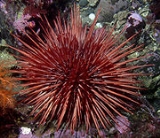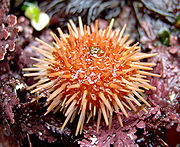
Red sea urchin
Encyclopedia
Strongylocentrotus franciscanus, commonly called Red Sea Urchin (although its color ranges from pink or orange to nearly black), is a sea urchin
found in the Pacific Ocean from Alaska
to Baja California
. It lives in shallow waters from the low-tide line to 90 metres (295.3 ft) deep, and is typically found on rocky shores that are sheltered from extreme wave action.
 A Sea Urchin’s spherical body is completely covered by sharp spines that can grow up to 8 cm. These spines grow on a hard shell called the “test”, which encloses the animal. The oldest ones have been measured to be around 19 cm in diameter. It can vary in color from red to dark burgundy. Rarely, albino specimens are found. A sea urchin has no visible eyes or legs. It has a mouth located on its underside, which is surrounded by 5 teeth. During larval development, the body of a sea urchin transitions from radial to bilateral symmetry.
A Sea Urchin’s spherical body is completely covered by sharp spines that can grow up to 8 cm. These spines grow on a hard shell called the “test”, which encloses the animal. The oldest ones have been measured to be around 19 cm in diameter. It can vary in color from red to dark burgundy. Rarely, albino specimens are found. A sea urchin has no visible eyes or legs. It has a mouth located on its underside, which is surrounded by 5 teeth. During larval development, the body of a sea urchin transitions from radial to bilateral symmetry.
This bilaterally symmetrical larva, called an echinopluteus, subsequently develops a type of pentaradiate symmetry that characterises echinoderms. It crawls very slowly over the sea bottom using its spines as stilts, with the help of its tube feet
. Scattered among its spines are rows of tiny tube feet with suckers that help it to move and stick to the sea floor.
Spawning peaks between June and September. Eggs
are fertilized externally while they float in the ocean, and planktonic larvae (echinopluteus) remain in the water column for about a month before settling on the bottom of the sea floor, where they undergo metamorphosis into juvenile urchins. These juveniles use chemical cues to locate adults. Although juveniles are found almost exclusively under aggregated adults, the adults and juveniles are not directly related. Red Sea Urchins can effectively reproduce even if they are incredibly old.
Sea urchin
Sea urchins or urchins are small, spiny, globular animals which, with their close kin, such as sand dollars, constitute the class Echinoidea of the echinoderm phylum. They inhabit all oceans. Their shell, or "test", is round and spiny, typically from across. Common colors include black and dull...
found in the Pacific Ocean from Alaska
Alaska
Alaska is the largest state in the United States by area. It is situated in the northwest extremity of the North American continent, with Canada to the east, the Arctic Ocean to the north, and the Pacific Ocean to the west and south, with Russia further west across the Bering Strait...
to Baja California
Baja California
Baja California officially Estado Libre y Soberano de Baja California is one of the 31 states which, with the Federal District, comprise the 32 Federal Entities of Mexico. It is both the northernmost and westernmost state of Mexico. Before becoming a state in 1953, the area was known as the North...
. It lives in shallow waters from the low-tide line to 90 metres (295.3 ft) deep, and is typically found on rocky shores that are sheltered from extreme wave action.
Physical description

This bilaterally symmetrical larva, called an echinopluteus, subsequently develops a type of pentaradiate symmetry that characterises echinoderms. It crawls very slowly over the sea bottom using its spines as stilts, with the help of its tube feet
Tube feet
Tube feet are the many small tubular projections found most famously on the oral face of a sea star's arms, but are characteristic of the water vascular system of the echinoderm phylum which also includes sea urchins, sand dollars and sea cucumbers and many other sea creatures.Tube feet function in...
. Scattered among its spines are rows of tiny tube feet with suckers that help it to move and stick to the sea floor.
Feeding habits
The animals have a mouth with special jaws (Aristotle's Lantern) located on the bottom (oral) surface. Their preferred diet is seaweeds, kelp and algae, which they scrape off and tear up from the sea floor. During larval development, urchins use bands of cilia to capture food from the water column.Behavior and reproduction
Sea Urchins are often found living in clumps from five to ten. They have the ability to regenerate lost spines. Lifespan often exceeds 30 years, and scientists have found some specimens to be over 200 years old.Spawning peaks between June and September. Eggs
Egg (biology)
An egg is an organic vessel in which an embryo first begins to develop. In most birds, reptiles, insects, molluscs, fish, and monotremes, an egg is the zygote, resulting from fertilization of the ovum, which is expelled from the body and permitted to develop outside the body until the developing...
are fertilized externally while they float in the ocean, and planktonic larvae (echinopluteus) remain in the water column for about a month before settling on the bottom of the sea floor, where they undergo metamorphosis into juvenile urchins. These juveniles use chemical cues to locate adults. Although juveniles are found almost exclusively under aggregated adults, the adults and juveniles are not directly related. Red Sea Urchins can effectively reproduce even if they are incredibly old.

